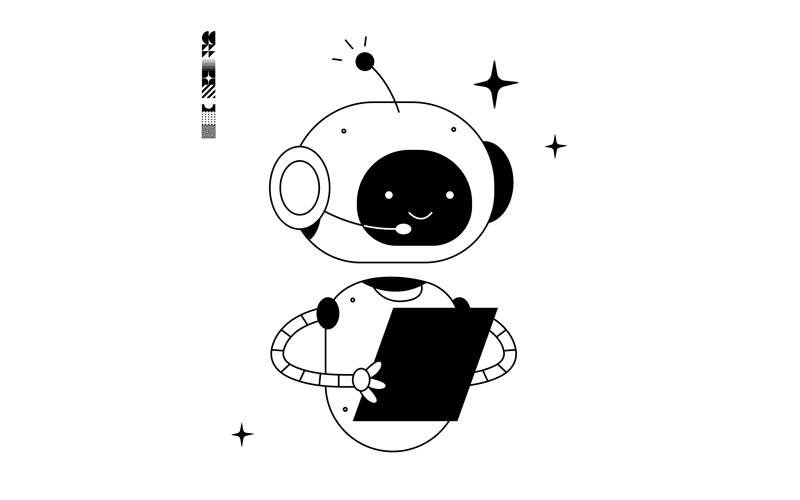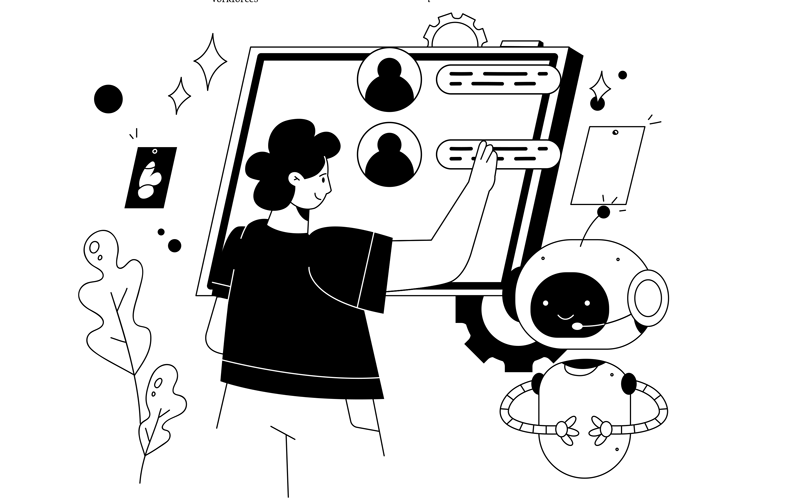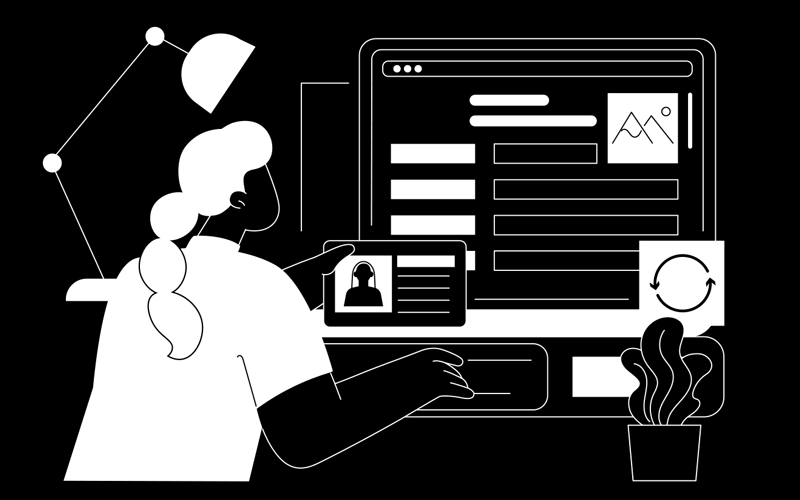AI agents are coming

Rather than being seen as the enemy, the recruitment industry should view AI agents as an exciting new dawn.
Recruiters are used to being at the coalface of digital revolutions. From the early days of job boards and applicant tracking systems (ATS) through to the march of artificial intelligence (AI), they’ve had to adapt their mindsets and processes to adjust to new ways of working. Added to that, with nearly every sector subject to some form of digital transformation over the past 25 years or more, they’ve also had to help navigate a path for their clients who have witnessed roles being lost, created new ones and dramatically reshaped workforces because of technology.
Now, they must prepare for what could prove to be the most radical shift yet: integrating advanced and autonomous AI technologies into their daily lives and work practices as well as helping clients to build a blended workforce of humans and AI agents, capable of automating a huge range of tasks. To some it will sound like the future they feared, finally being replaced by technology wholesale. To others, it’s an exciting new dawn that could make the world of work far more interesting. But, either way, recruiters cannot shy away from this future.

AI agents are specific applications of agentic AI, a field of AI that acts on its own, making decisions and taking action without any input from humans. They also have powers of reasonings, enabling them to problem-solve and to adapt through their own continuous learning.
Intelligent agents aren’t new but the emergence of large language models (LLMs) like OpenAI’s GPT-4.0 and Google’s Gemini are creating a wave of far more sophisticated autonomous agents as well as fuelling major market growth. According to research and analysis company Market.us, agentic AI in recruitment and HR market is projected to surge from almost $23.2m (£17.4m) in 2024 to $842.3m in 2024, representing a compound annual growth rate of almost 40% from 2025 until 2034. It cites growth areas as AI-driven candidate screening, predictive hiring and the demand for data-driven decision-making.
“Agentic AI means AI that doesn’t just assist – it acts,” said Barend Raaff, co-founder of AI recruitment platform developer, Carv. “It takes real responsibility for recruitment tasks, like sourcing, screening, or updating systems. Think of it as a reliable colleague you can delegate to – not a tool you have to operate.”
He adds that agentic AI can work across the board for recruiters. “In high-volume hiring, it saves time by handling repetitive tasks at scale. In specialist hiring, it gives recruiters back time to focus on finding the right fit. The value is universal – speed, consistency, and more room for human judgement where it matters most.”

CASE STUDY: DWIGHT in action
DeWinter is a US-based staffing company specialising in finance, accounting and technology. Brandon Simmons, executive vice president of technology and operations, explains that the company had been trying to build an integration between its payroll and onboarding/HRIS system, Paylocity and its ATS Bullhorn for two years without success due to complications with available APIs (Application Programming Interfaces). In addition, the cost of the integration build itself was not feasible for a mid-size staffing firm. It turned to DWIGHT for its ability to automate workflows between systems that did not integrate. In addition, it wanted to increase its operational efficiency and create “a great and expedited experience” for consultants.
Simmons explains that DWIGHT has helped increase efficiency through automated onboarding, which can now take place 24/7, as well as reduce data error risk. “This has also significantly reduced operational overhead costs to the business. It has also brought cost efficiency as we are able to deploy DWIGHT at a fraction of what we would have to pay a person to do the work.”
Before automation, three full-time staff undertook the work.
Simmons explains that one of its main priorities was to repurpose a team that was mostly doing admin/data work and enable them to become more consultant and client-facing to provide proactive support. “It freed their time up to do what humans do best – and always will – build relationships,” he says.
Given the replacement fear factor that can accompany technology, Simmons explains that it is important to get the communication right around such deployments.
“Our team understands that our focus is to provide them more space to drive human connections and value so I think that inherent fear that people feel can be overcome with good upfront communication across the organisation as to our thought process and approach to the utilisation of tools like robotic process automation (RPA) and AI.”
The team interacts with DWIGHT via a dashboard and because DeWinter fully mapped out the workflow design, there were no surprises or learning curves to deal with. “Only the ‘awe’ of watching DWIGHT complete a process that used to take our team 45 minutes during normal work hours – if they were uninterrupted – to now being completed in under four minutes, 24 hours/day.”
DeWinter has further plans to utilise DWIGHT across the organisation for some field-facing tasks as well as continuing to expand its use in the middle and back office.
Simmons’ advice to other organisations exploring the use of AI agents is not to be afraid and to take a hard look at your workflows and business processes to see what efficiencies you could gain and what high-value work your team could do if they were not focused on data entry and admin work.
“Staffing, as an industry, has always had a proclivity to throw people at problems and in some cases RPA and AI are better and more cost-effective, long-term solutions.”
As already stated, agents can bring their own judgement into play. There are even suggestions that they may even be able to spot something in a candidate that a recruiter may miss. Certainly, we can expect ever more sophisticated agents in the coming months. HireVue, for instance, recently revealed its Match and Apply chatbot, which instead of relying on keyword matching or scripted prompts, adaptively considers a candidate for all relevant roles while personalising the experience to ensure no opportunity is missed.
Raymond Pennie, CEO and founder of Kyloe Partners, a Bullhorn global system integration partner, believes AI agents, which can also be referred to as digital workers and digital assistants, are going to be “huge” for recruitment owners in the short and medium term. “They offer the options to double the capacity and raise your standards. Imagine contacting all candidates, screening them and allowing your most expensive resourcers to engage/speak to the most well-suited candidates for your clients. Admin will be done for you just like the old days when teams had administrators,” he says, adding that they will enable recruiters to be “better briefed” all the time. “Nothing will be forgotten, and everyone will be engaged fully.”
It is early days, and not all AI agents are fit for purpose. Moreover, there will always be cynicism in some quarters about how effective AI agents can be but there is plenty of real-world examples to show why they must be taken seriously.
Users of Carv’s AI platform include major employers such as DHL, Carrefour as well as Manpower Group. DHL Express’ hiring methods were unable to keep up with the speed and scale required to meet its business goals so turned to Carv’s conversational AI solution to streamline operations and boost recruiter productivity. It integrated the technology with its existing ATS platform, Jobylon, which allowed job postings to be easily converted into AI-powered chat flows that pre-screen candidates in real-time and automatically schedule interviews via WhatsApp.
DHL Express reports that it improved recruiter productivity, with 26 hours a week saved per recruiter, increased hires by a third and managed to undertake 1,000+ daily candidate conversations.
Global mobility platform EasyPark is using Google Cloud’s AI capabilities to streamline onboarding. An intelligent agent serves as a companion to every new employee, providing instant access to information and guiding individuals through the onboarding process. Gemini uses advanced natural language processing and understanding and the agent can comprehend and respond to complex queries.
Recruiters can focus on actual conversations, not admin. And for candidates, the process feels more responsive and human– ironically, thanks to AI
Meanwhile, Yasar Ahmad, global vice president, People Team, at recipe box company HelloFresh, says the company plans to use agentic AI for tasks that are predictable and can be automated around onboarding. “Use cases are currently developing on a daily basis,” he says, adding that he also believes agentic AI will support in areas like debriefing, candidate feedback and rescheduling. “Beyond that it is hard to tell as a lot of it looks good, but practical implementation across different systems can be a lot harder.”
Carv’s Raaff explains that while the technology can be applied across the full recruitment journey, recruiters can start with one task or hand over several. He adds: “You get time back. You get better data. You get a more consistent candidate experience. Recruiters can focus on actual conversations, not admin. Companies move faster and hire smarter. And for candidates, the process feels more responsive and human – ironically, thanks to AI.”
Clearly, there will also be concerns about replacing human workers given that any technology that delivers cost-savings and efficiency gains by streamlining often equals a reduction in headcount. Pennie believes in the long term, such agents have to be seen as a threat for some roles and do leave some recruiters feeling uncomfortable. “Everyone knows that AI is a must-have but the implementation of it is still a puzzle,” he says. “We see the early adopters reaping rewards and the old school are finding reasons to leave it until next year. There are also splits inside businesses where not all recruiters/managers ‘get it’ and this will mean changes on the company leaderboards.”
Raaff sees it as replacing “tasks not people” but adds: “Recruiters who embrace AI will be freed from repetitive work and become more strategic. But yes, teams that don’t adapt may find themselves outpaced by those that do.”
Dries De Coster, CEO, of meet DWIGHT, formerly known as Chat Automation, explains that while digital workers are about saving money and streamlining, they are also about creating more meaningful work and ridding the workplace of many of the jobs people don’t want to do anyway. DWIGHT, which stands for Digital Worker Interface for Generic Human Tasks, automates middle- and back-office processes, which he says is a fairly “untapped area”.
“We describe ourselves as living in the cracks. There’s a lot of AI and automation that happens at the top of the funnel on the sales side but what we do is automate in areas like onboarding, compliance, credentialing, time-sheeting and also work with vendor management services (VMS) and managed service provider (MSP) platforms. Margins are obviously getting squeezed – particularly in the temp world – and automation can bring cost-savings in these areas.”
DWIGHT can navigate around a lack of APIs between systems and can enter the process at any stage, depending on the client’s needs.
De Coster says its aim is to solve a business problem rather than talk about technology, and the case study on US staffing firm DeWinter shows how DWIGHT tackled a major pain point at the onboarding stage (see Case Study, above). For another client, it is automating the work of 12 onboarders. He also explains how DWIGHT can help when a temp’s contract is coming to an end and another role is sought. DWIGHT is triggered into action by a date and then goes on to identify, for example, that the person is a teacher who wants to remain working in the Cambridge area. It goes off to find suitable open vacancies and emails them to the candidate. “Where candidates are somewhat scarce, it helps agencies hold on to people they’ve already onboarded so they don’t lose them to other agencies. In this way DWIGHT can be more revenue-generative than cost-saving.”

He says other benefits of DWIGHT are a speeding up of the whole candidate experience – “and obviously the speed to the pound for our clients” – and higher retention rates because people are more engaged with their work. Meet DWIGHT recently signed up a new recruiter who was looking for a credit controller to automate its whole accounts payable process. “Rather than hiring a person they are using DWIGHT at a fraction of the full-time equivalent (FTE) cost,” says De Coster. “We call this ‘grow without growing’.”
The company also has a handful of clients with offshoring teams who are now opting for DWIGHT.
The next incarnation of DWIGHT, De Coster explains, will be fused with agentic AI, increasing capabilities further. “DWIGHT runs autonomously in his current iteration and already has ‘rule-based’ intelligence. When infusing him with Agentic AI, we will be able to take his intelligent interpretations skills to the next level. The first step will likely be for DWIGHT to present his findings for human validation, until Agentic AI evolves further and ensures the correct interpretation takes place 100% of the time.”
There is still much to learn in this field but with cost and time pressures mounting, more and more recruiters are likely to explore the use of AI agents. They must be “thoughtfully implemented” like any system, says Raaff, and could cause confusion or even add complexity if not done so. “AI has to be embedded, not bolted on,” he says, but he adds that while it is early days, clients are going further than expected in some cases and once they start to hand over work to AI, they also start exploring new ways to use it: “It becomes part of their day, just like any other team member.”
The rise of digital and human teams
Viewing AI agents as another team member may still seem like a leap of imagination but workforces already are comprising digital as well as human workers, with support and services now building around this concept. In March, talent company the Adecco Group and Salesforce announced investments in a new company with the remit of helping organisations build an integrated workforce of humans and AI agents.
It reports that the company will empower senior leaders to strategically plan, deploy and manage workers and AI agents “at scale” and will make use of Salesforce’s digital labour platform called Agentforce for augmenting teams with trusted autonomous AI agents in workflows. In a press statement, Denis Machuel, CEO of the Adecco Group, said: “We are at a critical juncture for the future of work. Embracing AI adoption with a well-defined framework for collaboration between humans and digital agents sets the stage for successful outcomes.”
The new company plans to build agents on the Agentforce platform and list them on the AgentExchange marketplace. The latter was launched to help partners build and monetise agentic AI components and, with Adecco Group, it will seek to create “a digital labour model”.
Meanwhile, what claims to be the first job board for autonomous AI agents also launched this year. JobForAgent.com was co-founded by Poland-based Kamil Stanuch and Łukasz Wróbel. Stanuch describes the site as being at the proof-of-concept stage. “We have a growing community of over 680 AI builders and experts who have signed up, eager to apply their skills,” he says. “We’re seeing forward-thinking companies, including deep-tech start-ups like Quesma, posting specific tasks and roles designed for AI agents. We’ve also facilitated connections that are leading to real development.
“While we’re creating a new kind of connection point – more like a specialised marketplace than a traditional job board – the interest indicates a recognition that the nature of some work is changing, and new ways to source solutions are needed.”
He observes a mix of “intense curiosity, excitement and understandable caution” around the market: “Businesses are trying to figure out what’s real, what’s hype, and how they can leverage AI agents reliably and safely. We try to ground the conversation in practical reality – highlighting that, currently, many tasks are better suited to specific automations rather than requiring a fully autonomous agent just yet.”
The site also features the Job Analyser that gives a percentage score for how much potential there is for your job to be automated.
“We’ve seen significant usage, with hundreds of job descriptions analysed so far, and it consistently highlights substantial automation potential – averaging around 41% across the roles analysed,” says Stanuch. “The feedback suggests it’s a useful tool for both companies trying to understand where AI can provide value in their existing structures, and for professionals curious about how their own roles might evolve.”
Meanwhile, Freeday describes itself as a staffing platform for digital employees. It invites organisations to outsource “boring repetitive tasks” to its digital employees and has published a downloadable guide entitled ‘Benefits of a Digital Employee’.
The company name is based on the idea that everyone should be free on Friday. Founder Mathijs Gast said its customer service agent is currently being called upon to carry out the most transactions, with more acceptance around the notion of a digital employee.
“Because we make it very human, people can more easily think in possibilities instead of making it more tech focused,” he says. “We have many successful business cases where we see employee satisfaction rising significantly and people not having to do the mundane work. They really don’t want to work anymore without their digital employee.”
Although the narrative in this area tends to revolve around “apocalyptic” automation and replacement, Stanuch believes that AI agents should be more in the spectrum of “augmentation” and adds that, at the moment, not all AI agents may be fit for purpose. “A key point we emphasise is that humans are still very much in the loop; our platform connects companies with the people who build, deploy, and manage these agents,” he says.
Meanwhile, HelloFresh’s Ahmad reckons the future will be less about building a digital team and more of “what we’ve always done”. “Just iterating our process,” he says.
Image credit | Shutterstock
